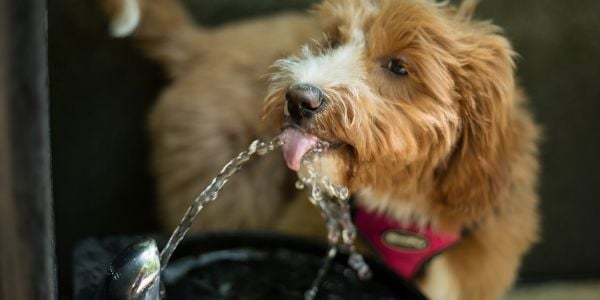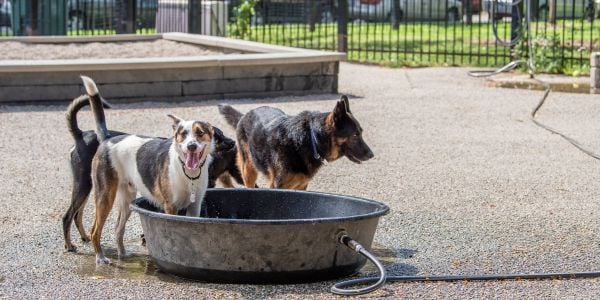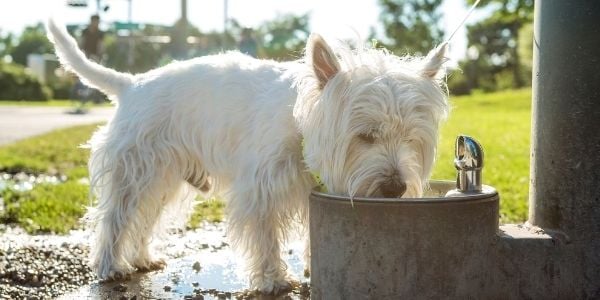
You might be thankful when you and your beloved dog are out and about on a warm day and see a water bowl sitting out to provide your dog with the hydration they so desperately need — but wait!
You may want to pause before letting your dog take that water break. Why? Because of the very real possibility that while your dog is quenching their thirst from a communal dog water bowl, they could also be lapping up bacteria, viruses, or even parasites that could make them quite sick.
You know what they say … a moment on the lips ... could lead to sleepless nights of regret. OK, even if that’s not really how that saying goes, it’s still a good idea to keep it in mind when you come across a public water bowl for your dog.
Here’s what you need to know and how you can safely keep your dog hydrated when out and about.
Until I moved to Colorado, I had never seen communal water bowls or fountains. As a veterinarian, knowing what's lurking inside them freaks me out! But they are common, so it's best to know the risks before you let your dog partake.

Germs and Diseases That Can Be in Communal or Public Dog Water Bowls
Dog bowls can be cesspools of all kinds of disease-causing microbes. A 2011 study from the National Sanitation Foundation (NSF) found that dog bowls are the fourth “germiest” item in our homes.
In 2018, researchers from Hartpury University in the United Kingdom supported this finding and actually ranked dogs’ water bowls as the third most contaminated household item. And that’s in our homes … imagine how much germier public dog bowls are!
Communal water bowls put healthy dogs are risk of disease. That risk significantly increases for those dogs with immature or compromised immune systems and, therefore, should be avoided at all costs.
Puppies have an immature immune system and are unable to ‘fight’ off certain diseases and infections the same way a healthy adult dog can. For example, giardia is not typically a life-threatening disease, but it can be for a puppy since it can result in dehydration quickly and nutrient loss.
Senior dogs with a weakened immune system and adult dogs with compromised immune systems due to health issues or medications (steroids, cyclosporin, chemotherapy) are at a significant risk of developing diseases when they drink from public water bowls. Just like a puppy, their immune system can’t fight off the foreign invaders. Illnesses that would normally have minimal effects can result in serious complications and even death for these dogs.
Giardia
This protozoal parasite of the intestines causes Giardiasis (sometimes called “Beaver Fever”) and is a common cause of diarrhea in dogs. The degree or severity of diarrhea that Giardia infection causes in dogs varies and can range from mild to severe, depending on the subtype of Giardia the dog is infected with, their parasite load, their age, health status, and a host of other factors. Some dogs can even be what we call “subclinical shedders,” meaning that they’re infected with the Giardia parasite and shedding the infective cysts (meaning that they can serve as a source of infection for other dogs), yet they’re not showing any signs of diarrhea.
Giardia is spread by fecal contamination, or what’s called the “fecal-oral route,” and the Giardia parasite doesn’t just survive in water; it actually thrives in it!
And while most dogs don’t go around pooping in water bowls, there is always the dog that LOVES to eat poop, and plenty of them do stick their paws in and play with the water in water bowls! And if any of those mouths sampled Giardia-contaminated poop or their paws have recently walked on Giardia-contaminated ground, poop, or a puddle, that’s all it takes to create a nice “Giardia soup” for your pup to slurp down.
There is no vaccine to help protect against Giardia in dogs. Learn more about Giardia, including how it can even sicken people.
Leptospirosis
Similar to the Giardia parasite, the Leptospire bacteria (the causative organism of Leptospirosis) absolutely LOVE water! The infective bacteria are spread through urine from an infected animal, and it doesn’t even need to be another dog. In fact, one of the most common ways Lepto bacteria find their way into water is from infected rodents, like rats and mice. And whether you’ve seen them or not, rodents are pretty common in and around dog parks (and throughout many cities, too)! It is also important to know that rats and mice aren’t the only wild animals to carry the Leptospire bacteria. Other animal carriers include squirrels, opossums, raccoons, skunks, foxes, and deer.
While most dogs won’t poop into the water bowl at the dog park, there are plenty of dogs that will pee in them!
One of the main problems that Lepto causes in dogs is kidney failure, which means that an affected dog is likely to drink and pee a ton more as their kidneys progress through the different stages of failure.
Lepto is highly contagious amongst dogs, and, like Giardia, Lepto is also a zoonotic public health risk that can affect people.
There are safe and effective vaccines to help protect dogs from Lepto — talk to your vet about the vaccine for your dog. Learn more about Leptospirosis on the CDC website.

Intestinal Worm Parasites
The infective eggs of common canine intestinal worm parasites, such as roundworms, hookworms, and whipworms, can be found in fecal-contaminated water bowls.
Again, think of all the dogs you see using their paws to splash around and play with the water in a water bowl. If that paw has recently stepped in poop, dug in, or walked over ground that is contaminated with intestinal worm eggs — all of which is quite likely in a dog park or on a hike — then there’s a good chance that the water they’re dipping their paws into is now also contaminated.
Roundworms, hookworms, and whipworms don’t just cause diarrhea in dogs, but they can also cause blood and protein loss from the gut, too. The loss of blood and/or protein from the gut can lead to lethargy, weakness, pale mucus membranes, fluid accumulation within the abdomen, and a host of other problems.
Besides how these parasites affect your dog, roundworms and hookworms are zoonotic (infections humans get from animals). By protecting your dog, you are also protecting yourself.
Thankfully, most of the common monthly heartworm preventatives also help to protect against many of the common canine intestinal worms.
Coccidia
Another common protozoal parasite of the canine gut, the Coccidia organisms, can cause abdominal pain and diarrhea in infected dogs. In many dogs, infection with the Coccidia organisms is either mild or doesn’t show any signs at all. However, in young puppies and older dogs who may have an immature or weakened immune system, either from certain types of cancer or from being on immune-suppressive medications, like steroids, cyclosporine, or chemotherapy, a coccidial infection can cause more serious diarrhea and disease.
There is no vaccine to help protect dogs from Coccidia. Diagnosis is made via fecal analysis done by a veterinarian.

E. coli and Salmonella
Both E. coli and Salmonella can cause disease and sickness in dogs — typically vomiting and diarrhea, but if the bacteria gain access to the bloodstream, an affected dog could develop endotoxemic shock (weakness, rapid breathing, and pulse rates, pale mucus membranes, collapse, low blood pressure), which is fatal without treatment (and sometimes even with!).
Both types of bacteria can survive for extended periods of time in water. Studies find the numbers of bacteria were higher in plastic and ceramic bowls as compared to stainless steel.
The degree and severity of illness caused depends on the age, immune status, and multiple other factors of the dogs infected. But that’s not the only problem; both of these types of bacteria can also cause disease in people who come into contact with them, and dogs that become infected can act as an infection source for their people when they “shed” the bacteria.
Dogs fed a raw diet are often the biggest concern when it comes to shedding pathogenic bacteria, especially Salmonella, which can infect other dogs and even people. There are no vaccines to help protect dogs against E. coli or Salmonella.
Parvo and Canine Influenza Virus
Note that while the viruses that cause Parvo (Parvovirus) and Dog Flu (Canine Influenza Virus) can very easily be spread and caught from water bowls, it’s more from the dry parts of the water bowls, as water can have a diluting effect on the spread of these viruses.
So, while both of these viruses are HIGHLY contagious amongst dogs, drinking water contaminated by them isn’t one of the main methods through which they’re spread.
Thankfully, there are safe and effective vaccines to help protect dogs from Parvo and Dog Flu. Be sure to discuss these vaccinations with your vet and ensure that your dog is up-to-date on their shots.
Canine Papilloma Virus
Papillomas are common benign tumors of dogs caused by a virus. These ‘warts’ are typically present around the mouth on the lips, tongue, or gums. Dogs become infected with this virus via direct contact with other infected dogs or through environmental spread.
If an infected dog sneezes or drools in a communal water bowl, it can spread the canine papillomavirus. This virus is more prone to develop in young dogs and puppies with immature immune systems as well as those with compromised immune systems.
Are All Communal Dog Bowls a Danger?
While all communal or public dog bowls could pose a health risk to your dog, certain factors can, thankfully, make some bowls safer than others.
Here’s what to know and look for should your dog need a quick drink on the go:
How Often (and How) the Bowl Is Cleaned
It stands to reason that a bowl that’s properly cleaned and disinfected on a daily basis is going to be safer than one that’s cleaned less often (or even not at all — as likely frequently happens with dog park or hiking path bowls). However, the material the bowl is made of greatly affects how clean you can get a bowl. See more on that below.
Bowls can be cleaned in the dishwasher (so long as the bowls are dishwasher-safe) or by hand washing with hot water and soap.
Disinfecting can be accomplished by a sanitary cycle in the dishwasher or soaking for 10 to 15 minutes in a 1:50 dilution of bleach water. If using bleach water, always be sure to rinse and then dry thoroughly after! If you don’t have a dishwasher and bleach is a turn-off for you, soak the dish in warm vinegar for 15 minutes. Rinse well with warm water. Then spray it with hydrogen peroxide and let it sit for 5 to 10 minutes. Rinse well and air dry.
Water Bowl Material
- Stainless steel bowls are the clear winners in terms of the dog bowl material that’s least likely to harbor germs that’ll make your dog sick. Stainless steel is the easiest to clean and disinfect and often the most difficult to scratch or otherwise damage (so long as someone isn’t using steel wool or anything else abrasive to clean the bowl). And this lack of scratches and cracks is good because bacteria and other "nasties" love hanging out in them and making dogs sick.
NOTE: Some stainless steel is of poor quality, especially if the material was imported, and can contain lead or radioactive material. In 2013, there was a recall by Petco due to radioactive cobalt-60 being found in bowls from overseas manufacturers. Not all stainless-steel bowls (e.g., those manufactured outside the U.S.) are made by companies that manufacture under the Good Manufacturing Process (GMP), and therefore, there is no guarantee that safe materials or manufacturing processes have been used or that the product is free of harmful toxins.
- Glass often comes in second in terms of ease of cleaning and not harboring germs, but because glass can be easily chipped or broken and then cause injury to dogs, it’s not really a common or safe option for communal dog bowls at dog parks or on the sidewalk in front of pet-friendly shops.
Something else to know about glass bowls is that any glass not manufactured within the U.S. does not have the same regulations and may potentially include additives that are not safe for food contact.
- Ceramic bowls, like glass, can be easy to clean, but they’re also prone to chipping and breaking, leading to a potential injury.
Also, this 2018 study out of Hartpury University in the UK showed that ceramic bowls actually supported the growth of quite a few different types of bacteria. The study’s authors suggest it might be due to an increased ability of the bacteria to produce and “hide behind” biofilm on the ceramic material. Additionally, the glaze used on some ceramic dishes may contain lead or other toxins which are not safe. Pet versions of ceramic dishes do not have to be certified as safe for food. - Plastic dog bowls are far and away the worst type of bowl in terms of risk for harboring bacteria and other infectious creepy crawlies, especially in a public environment. One of the main reasons for this is that most plastic bowls are easily scratched or otherwise damaged, leading to defects in the material that provide great places for these microbes to overgrow and even withstand the cleaning process.
The Location of the Bowl
Bowls in dog parks and along hiking paths are likely a greater infection risk to your dog than a bowl that’s outside of your favorite pet-friendly shop, just because of the environment, wild animals, and the number of dogs likely to be drinking out of it. And also because the shop owner is cleaning the bowl more often. Hopefully!

Are Public Dog Fountains Safe to Use?
Human drinking fountains harbor germs and bacteria. Testing of elementary school fountains, conducted by the National Sanitation Foundation found 2.7 million bacterial cells per square inch. If human fountains were this nasty, imagine what would be found on a public dog drinking fountain that is very likely cleaned less often.
Dogs will lick and play with fountains just the same as they will with bowls. Therefore, the risks are just the same.
With that said, filling a water bottle or your own bowl from the spout after the water has been running a bit and without direct contact, is likely okay.
Play It Safe
Anthony Hopkins said, “Danger is the spice of life, and you got to take a risk now and then.” This statement certainly doesn’t apply when trying to decide if your dog should drink from a communal water bowl. The risks far outweigh the benefits when you let your dog drink with others.
Err, on the side of caution, carry a collapsible water bowl and a bottle of water when you are out with your dog. This simple little action can save you both a lot of sleepless nights and allow for more risky fun in other ways! Our team uses and loves these portable water bottles and bowls.
Bonza portable bowl that is 100% BPA-free and food and dishwasher-safe.
The Pupflask is a stainless steel bottle that is food safe and has a collapsable silicone water cup attached. You can also buy its neoprene insulated shoulder holster, which makes it easy to carry on walks.




